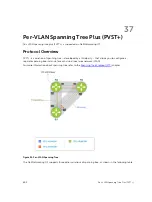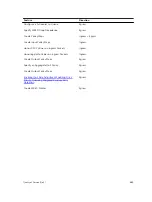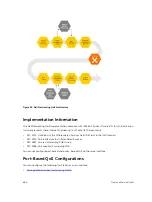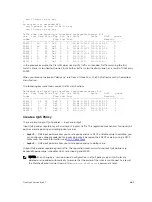
Example of Configuring an Interface to Honor dot1p Priorities on Ingress Traffic
Dell#configure terminal
Dell(conf)#interface tengigabitethernet 1/1
Dell(conf-if-te-1/1)#service-class dynamic dot1p
Dell(conf-if-te-1/1)#end
Priority-Tagged Frames on the Default VLAN
Priority-tagged frames are 802.1Q tagged frames with VLAN ID 0. For VLAN classification, these packets
are treated as untagged. However, the dot1p value is still honored when you configure
service-class
dynamic dot1p
or
trust dot1p
.
When priority-tagged frames ingress an untagged port or hybrid port, the frames are classified to the
default VLAN of the port and to a queue according to their dot1p priority if you configure
service-
class dynamic dotp
or
trust dot1p
. When priority-tagged frames ingress a tagged port, the frames
are dropped because, for a tagged port, the default VLAN is 0.
Dell Networking OS Behavior
: Hybrid ports can receive untagged, tagged, and priority tagged frames.
The rate metering calculation might be inaccurate for untagged ports because an internal assumption is
made that all frames are treated as tagged. Internally, the ASIC adds a 4-bytes tag to received untagged
frames. Though these 4-bytes are not part of the untagged frame received on the wire, they are included
in the rate metering calculation resulting in metering inaccuracy.
Configuring Port-Based Rate Policing
If the interface is a member of a VLAN, you may specify the VLAN for which ingress packets are policed.
• Rate policing ingress traffic on an interface.
INTERFACE mode
rate police
Example of the
rate police
Command
Dell#configure terminal
Dell(conf)#interface tengigabitethernet 1/1
Dell(conf-if-te-1/1)#rate police 100 40 peak 150 50
Dell(conf-if-te-1/1)#end
Configuring Port-Based Rate Shaping
Dell Networking OS Behavior
: Rate shaping is effectively rate limiting because of its smaller buffer size.
Rate shaping on tagged ports is slightly greater than the configured rate and rate shaping on untagged
ports is slightly less than configured rate.
Rate shaping buffers, rather than drops, traffic exceeding the specified rate until the buffer is exhausted. If
any stream exceeds the configured bandwidth on a continuous basis, it can consume all of the buffer
space that is allocated to the port.
• Apply rate shaping to outgoing traffic on a port.
INTERFACE mode
rate shape
• Apply rate shaping to a queue.
656
Quality of Service (QoS)
Содержание Z9000
Страница 1: ...Dell Configuration Guide for the Z9000 System 9 7 0 0 ...
Страница 80: ...grub reboot 80 Management ...
Страница 128: ... 0 Te 1 1 Te 1 2 rx Flow N A N A 128 Access Control Lists ACLs ...
Страница 436: ...Figure 50 Inspecting Configuration of LAG 10 on ALPHA 436 Link Aggregation Control Protocol LACP ...
Страница 439: ...Figure 52 Inspecting a LAG Port on BRAVO Using the show interface Command Link Aggregation Control Protocol LACP 439 ...
Страница 440: ...Figure 53 Inspecting LAG 10 Using the show interfaces port channel Command 440 Link Aggregation Control Protocol LACP ...
Страница 491: ...Figure 70 Configuring OSPF and BGP for MSDP Multicast Source Discovery Protocol MSDP 491 ...
Страница 492: ...Figure 71 Configuring PIM in Multiple Routing Domains 492 Multicast Source Discovery Protocol MSDP ...
Страница 496: ...Figure 73 MSDP Default Peer Scenario 1 496 Multicast Source Discovery Protocol MSDP ...
Страница 497: ...Figure 74 MSDP Default Peer Scenario 2 Multicast Source Discovery Protocol MSDP 497 ...
Страница 498: ...Figure 75 MSDP Default Peer Scenario 3 498 Multicast Source Discovery Protocol MSDP ...
Страница 760: ...Figure 100 Single and Double Tag TPID Match 760 Service Provider Bridging ...
Страница 761: ...Figure 101 Single and Double Tag First byte TPID Match Service Provider Bridging 761 ...






























